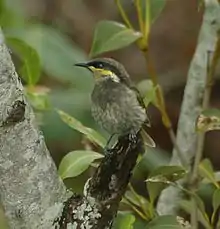Gavicalis
Gavicalis is a genus of honeyeaters endemic to New Guinea and Australia. It contains former members of Lichenostomus, and was created after a molecular phylogenetic analysis published in 2011 showed that the original genus was polyphyletic.[1]
| Gavicalis | |
|---|---|
.jpg.webp) | |
| Gavicalis virescens (singing honeyeater) | |
| Scientific classification | |
| Kingdom: | Animalia |
| Phylum: | Chordata |
| Class: | Aves |
| Order: | Passeriformes |
| Family: | Meliphagidae |
| Genus: | Gavicalis Schodde & Mason IJ, 1999 |
The genus contains three species:[2]
| Image | Scientific name | Common Name | Distribution |
|---|---|---|---|
_(31359494696).jpg.webp) | Gavicalis versicolor | Varied honeyeater | New Guinea, northeast Australia |
 | Gavicalis fasciogularis | Mangrove honeyeater | east Australia |
_(8079661576).jpg.webp) | Gavicalis virescens | Singing honeyeater | Australia |
The name Gavicalis was first proposed by the Australian ornithologists Richard Schodde and Ian Mason in 1999.[3] The word is an anagram of Caligavis introduced by Tom Iredale.[4]
References
- Nyári, Á.S.; Joseph, L. (2011). "Systematic dismantlement of Lichenostomus improves the basis for understanding relationships within the honeyeaters (Meliphagidae) and historical development of Australo–Papuan bird communities". Emu. 111: 202–211. doi:10.1071/mu10047.
- Gill, Frank; Donsker, David (eds.). "Honeyeaters". World Bird List Version 6.1. International Ornithologists' Union. Retrieved 28 January 2016.
- Schodde, Richard; Mason, Ian J. (1999). The directory of Australian birds : a taxonomic and zoogeographic atlas of the biodiversity of birds in Australia and its territories. Collingwood, VIC Australia: CSIRO. pp. 1–851. ISBN 978-064306456-0.
- Jobling, James A (2010). The Helm Dictionary of Scientific Bird Names. London: Christopher Helm. p. 171. ISBN 978-1-4081-2501-4.
This article is issued from Wikipedia. The text is licensed under Creative Commons - Attribution - Sharealike. Additional terms may apply for the media files.